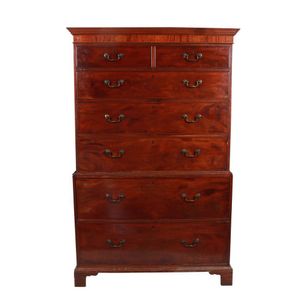Georgian Mahogany Tallboy Chest of Drawers
You must be a subscriber, and be logged in to view price and dealer details.
Subscribe Now to view actual auction price for this item
When you subscribe, you have the option of setting the currency in which to display prices to $Au, $US, $NZ or Stg.
- Georgian - As an English stylistic period, Georgian is usually taken to cover the period from George I (1714) to the Regency of Prince George (1811-20), although the period from 1800 to 1830 is sometimes designated as the Regency period. During the Georgian period the great English cabinetmakers and designers such as Chippendale, Hepplewhite, Adam Sheraton etc., were all active.
Therefore there isn't a single 'Georgian style' as such and to say something is 'Georgian', usually means it was made between 1714 and 1830. This assumes we discount George V and George VI, both being from the 20th century.
The styles popular at the time of each reign were:
George I (1714-1727) saw out the last years of the Baroque period.
George II (1727-1760) reigned during the Rococo period.
George III (1760-1820) saw the last gasp of the Rococo, all of the early Neo-Classic 'Adam style' and most of the later neo-Classic 'Regency style'.
George IV (Prince Regent 1820-1830)encompassed the last of the 'Regency' style.
William IV's reign (1830-1837) was something of a no man's land (stylistically) and he wasn't a 'George' anyway. He covered the last glimmerings of 'Regency' and the start of the 'Victorian' style. - Mahogany - Mahogany is a dense, close grained red-coloured timber from the West Indies and Central America. It was first imported into Europe in the the early 18th century and its use continued through the 19th century. It was popular for furniture making because of its strength, the wide boards available, the distinctive grain on some boards, termed flame mahogany and the rich warm colour of the timber when it was polished.. The "flame" was produced where a limb grew out from the trunk of the tree, and this timber was usually sliced into veneers for feature panels on doors, backs and cornices.
Some terms used to describe mahogany relate to the country from which it originally came, such as "Cuban" mahogany, "Honduras" mahogany etc. However unless the wood has been tested the names assigned are more a selling feature, rather than a true indication of the timber's origin. - Graduated Drawers - A bank of drawers, where the top drawer has the least depth, and the depth of the each drawer is greater than the drawer above.
This item has been included into following indexes:
- chests of drawers, period - Georgian 763
-
chests of drawers, style
- chest on chest 143
- tallboys 32
Visually similar items

A George III mahogany chest on chest, early 19th century, 175 cm high, 115 cm wide, 53 cm deep

A cedar chest of drawers, Australian, circa 1870. 120 cm high, 121 cm wide, 50 cm deep

An Australian cedar 8 drawer chest with turned columns, Circa 1880. 130 cm high, 125 cm wide, 54 cm deep.

A New Zealand colonial mottled kauri scotch chest, the five top short drawers with crossbanded detail above three full width drawers, all with fancy silvered drop handles, rounded corners to the top, sides and platform base. 120 cm x 50.5 cm x 128 cm
